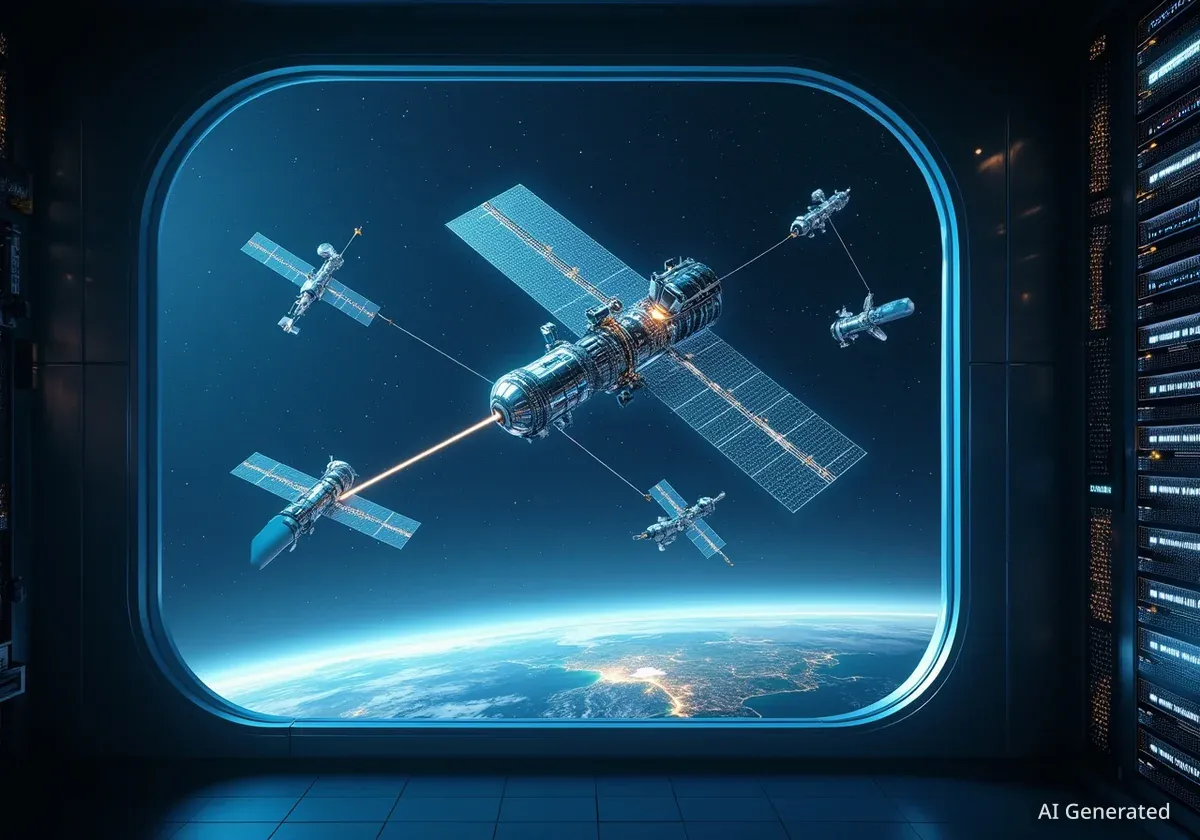The National Reconnaissance Office (NRO), a key U.S. intelligence agency, is increasingly relying on artificial intelligence to manage its rapidly expanding fleet of satellites. The agency has launched over 200 satellites in the last 30 months, making traditional manual control methods impractical, according to NRO Director Chris Scolese.
This shift towards AI-driven management is a direct response to the massive increase in data and operational complexity from its new, large-scale constellation in proliferated Low Earth Orbit (pLEO).
Key Takeaways
- The National Reconnaissance Office (NRO) launched over 200 satellites in a 24 to 30-month period.
- The agency is adopting artificial intelligence to control and coordinate its growing satellite constellations.
- The goal is to move from manual satellite commands to an automated system that can answer complex queries in plain language.
- Experimental satellites are already testing autonomous on-orbit decision-making capabilities.
A New Era of Satellite Operations
The NRO is undergoing a significant strategic change. Historically, the agency depended on a small number of large, highly sophisticated, and expensive satellites to conduct its missions. This model allowed for meticulous ground control by human operators.
However, the agency has embraced the trend of commercial spaceflight, launching a large number of smaller, more affordable satellites. This approach, known as a proliferated constellation, offers greater resilience and more comprehensive global coverage.
"In 24 to 30 months … we’ve launched over 200 satellites," Scolese stated at the INSA-AFCEA Intelligence & National Security Summit. This rapid expansion has created what he described as an "embarrassment of riches," where the sheer volume of assets and data has outpaced human capacity to manage them efficiently.
What is a Proliferated Constellation?
A proliferated Low Earth Orbit (pLEO) constellation consists of hundreds or even thousands of small satellites working together as a single system. This contrasts with traditional approaches that use a few large satellites in higher orbits. The benefits include redundancy (losing one satellite has less impact), more frequent revisits over a target area, and the ability to gather data from multiple angles simultaneously.
AI as the Central Nervous System
To address the management challenge, the NRO is turning to artificial intelligence. Scolese emphasized the need to use AI to simplify operations for both controllers and end-users of the intelligence data.
"We need to use the benefits of artificial intelligence … to control our constellations, to make it a lot easier for the user," Scolese explained.
The vision is to transition from a system where operators issue specific commands to individual satellites—a process Scolese described as "satellite X, do this"—to a more intuitive, query-based model. In this new paradigm, an intelligence analyst could ask a high-level question in natural language.
For example, a user might ask, "I want to know how many ships are in the Taiwan Strait." The AI system would then autonomously coordinate the entire constellation to answer the query. It would determine which satellites are in the best position, task their sensors, collect the necessary imagery or signals, and synthesize the information into a single, coherent report for the user.
The Challenge of Data Synthesis
Managing the physical movement of hundreds of satellites, which travel at speeds up to 17,000 mph in low orbit, is only part of the problem. The massive amount of data they generate presents an even greater challenge.
With multiple satellites observing the same region from different angles and at different times, the raw data can be complex and varied. Scolese highlighted the difficulty in combining this disparate information into a unified intelligence picture.
Data Integration is Key
According to Scolese, a primary challenge is how to effectively "stitch all that data" together. An AI system must be able to recognize that data from different sensors, looking at the same target under different conditions, all relates to the same object or event and then fuse it into a single, accurate analysis.
The NRO is actively seeking help from industry partners to develop advanced algorithms capable of this complex data fusion. This capability is essential to unlock the full potential of its proliferated architecture.
Testing Autonomy in Orbit
Beyond ground-based management, the NRO is also experimenting with AI for autonomous operations directly on its satellites. Scolese mentioned a research program called "Big Impact" designed to test these capabilities.
"They’re on a couple of satellites called Big Impact that are testing autonomous operations of space systems, where they can make decisions," he said. This would allow satellites to react to their environment or collaborate with other satellites without direct input from the ground.
Further details were provided by NRO's deputy director in separate remarks, who noted that a mission called "BIG IMPACT 2" had already launched. This mission involved two small 6U CubeSats designed to test the use of small-scale optics and on-orbit AI applications.
This research into on-orbit autonomy represents a forward-looking effort to create more resilient and responsive satellite systems that can adapt to changing conditions in real time.
Broader AI Implementation
While the focus is on mission-critical applications, the NRO has also integrated AI into its administrative functions. Much like commercial enterprises, the agency uses AI for back-office tasks.
"We use AI a lot," Scolese confirmed. "We use it everywhere, from our personnel systems [to] our financial systems." This foundational use of AI in business operations mirrors trends across the national security community, demonstrating a broad commitment to leveraging the technology for efficiency gains across the entire organization.
The NRO's comprehensive adoption of AI—from managing personnel to orchestrating complex intelligence-gathering operations in space—signals a fundamental shift in how the United States will conduct surveillance and reconnaissance from orbit in the future.





